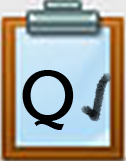Q1 What is a Global Collaborator?: Your Tools
Part 4 Choose Your Collaboration Tools
Tools for Talk in Global Collaboration
11. How do you get started?
- Begin by setting up online communication, or choosing digital tools to communicate in written, audio, or video form.
- Next, choose to collaborate synchronously (same time) or asynchronously (at a later time). This section will explore what you need to know to get connected.
CHOOSE YOUR TOOLS (Software & Hardware)
A. Tools or Apps (Software)
Using an online (virtual) tool to connect sites for the purposes of collaboration (connection) in real (live) time is called a virtual connection or a video conference.
A virtual connection can also include a “virtual meeting room” or an online workspace.
- Tools like Google Meet, Zoom, Microsoft Teams or Skype allows you to video conference virtually
- A virtual meeting room can include a space to upload documents, chat, or share and can be recorded.
- When you are sharing and recording, you are said to be broadcasting.
Talk to your teacher about the online tools available to you for this Thing.
B. Equipment (Hardware)
When participating in a webinar, you will need several things:
- An Internet connected or Cellphone Computing device with sound and microphone or headset with microphone
- Speakers or external speakers
- Device with a camera or a webcam
- A quiet place so you can hear and be heard
C. Always test your equipment before going live!
12. Choose the Time
Before you connect, you must understand the importance of time. First, you must think about the time zone that your connection is living in to determine if you can connect in real-time using synchronous communication. Use the World Map Time and Date Calculator to explore the time differences for possible connections.
13. Planning your live connection - Asynchronous (at a later time) or Synchronous (same time).
- Asynchronous: The difference between them is the TIME. By using tools that capture video or audio, like on a cell phone, you are creating something for viewing at a later time.
Examples:- Discussion boards
- Blogs
- Online social media forums (e.g. Facebook, Twitter, etc.)
- Creating a digital project (audio, video, or media) shared with participants in its final form
- Synchronous:When engaging in a video conference or instant message, you are communicating in live time at the same time.
- Instant messaging.
- Chatting via apps (e.g. What’s App, Snapchat, etc.)
- Video chat using free applications (e.g. Skype, Google Meet, Zoom, Facetime). Making Video Calls with Skype
- Please review this guide to Online Phone Calls to find out what you need to be successful.
- Videoconference using software that allows for multi-point connections (e.g.; Zoom or Teams). Many are similar to video chatting but are set up better for multi-point connections. Allows for screen sharing, recording the conference, etc.
- Many companies now do their hiring using virtual conferencing tools instead of in-person interviews.
- Understanding the commonly used communication tools will help you choose the right one for your collaboration.
- After reviewing the information on Time Zones, asynchronous, and synchronous communication, what ideas do you have for/about global collaboration?
14. Ready for Global Collaboration?
- Complete this Global Collaboration Questionnaire to see if you are ready to collaborate globally and to review your skills in these areas:
- Cultural Empathy
- Communication
- Teamwork
NOTE: The survey above links to a Google Doc that can be printed or copied. Your teacher may choose to take these questions and copy them into a Google Forms or Microsoft Survey and provide you with a link to answer the questions.
- When you are finished:
- Set two goals that will be used to evaluate your progress through this Thing.
- Choose two questions from the survey that indicate areas where you could develop your skills.
- With a partner, brainstorm ways that you could improve these skills. Use your Quest 1 notes template to identify your goal, two-three steps to take toward improvement, and a statement about how you will know if you have met your goal once you have completed the Quests and a Global Collaboration.
- You will return to this goal sheet in your final Quest to reflect on how your skills have changed.
Part 4
Step 1: How do you get started?
- Begin by setting up online communication, or choosing digital tools to communicate in written, audio, or video form.
- Next, choose to collaborate synchronously (same time) or asynchronously (at a later time). This section will explore what you need to know to get connected.
CHOOSE YOUR TOOLS (Software & Hardware)
A. Tools or Apps (Software)
Using an online (virtual) tool to connect sites for the purposes of collaboration (connection) in real (live) time is called a virtual connection or a video conference.
A virtual connection can also include a “virtual meeting room” or an online workspace.
- Tools like Google Meet, Zoom, Microsoft Teams or Skype allows you to video conference virtually
- A virtual meeting room can include a space to upload documents, chat, or share and can be recorded.
- When you are sharing and recording, you are said to be broadcasting.
Talk to your teacher about the online tools available to you for this Thing.
B. Equipment (Hardware)
When participating in a webinar, you will need several things:
- An Internet connected or Cellphone Computing device with sound and microphone or headset with microphone
- Speakers or external speakers
- Device with a camera or a webcam
- A quiet place so you can hear and be heard
C. Always test your equipment before going live!
Step 2: Choose the Time
Before you connect, you must understand the importance of time. First, you must think about the time zone that your connection is living in to determine if you can connect in real-time using synchronous communication. Use the World Map Time and Date Calculator to explore the time differences for possible connections.
Step 3. Planning your live connection - Asynchronous (at a later time) or Synchronous (same time).
- Asynchronous: The difference between them is the TIME. By using tools that capture video or audio, like on a cell phone, you are creating something for viewing at a later time.
Examples:- Discussion boards
- Blogs
- Online social media forums (e.g. Facebook, Twitter, etc.)
- Creating a digital project (audio, video, or media) shared with participants in its final form
- Synchronous: When engaging in a video conference or instant message, you are communicating in live time at the same time.
- Instant messaging.
- Chatting via apps (e.g. What’s App, Snapchat, etc.)
- Video chat using free applications (e.g. Skype, Google Meet, Zoom, Facetime). Making Video Calls with Skype
- Please review this guide to Online Phone Calls to find out what you need to be successful.
- Videoconference using software that allows for multi-point connections (e.g.; Zoom or Teams). Many are similar to video chatting but are set up better for multi-point connections. Allows for screen sharing, recording the conference, etc.
- Many companies now do their hiring using virtual conferencing tools instead of in-person interviews.
- Understanding the commonly used communication tools will help you choose the right one for your collaboration.
- After reviewing the information on Time Zones, asynchronous, and synchronous communication, what ideas do you have for/about global collaboration?
Step 4. Ready for Global Collaboration?
- Complete this Global Collaboration Questionnaire to see if you are ready to collaborate globally and to review your skills in these areas:
- Cultural Empathy
- Communication
- Teamwork
NOTE: The survey above links to a Google Doc that can be printed or copied. Your teacher may choose to take these questions and copy them into a Google Forms or Microsoft Survey and provide you with a link to answer the questions.
- When you are finished:
- Set two goals that will be used to evaluate your progress through this Thing.
- Choose two questions from the survey that indicate areas where you could develop your skills.
- With a partner, brainstorm ways that you could improve these skills. Use your Quest 1 notes template to identify your goal, two-three steps to take toward improvement, and a statement about how you will know if you have met your goal once you have completed the Quests and a Global Collaboration.
- You will return to this goal sheet in your final Quest to reflect on how your skills have changed.
Competencies & Standards
MITECS Michigan Integrated Technology Competencies for Students, and
1. Empowered Learner
a. Articulate and set personal learning goals, developing strategies leveraging technology to achieve them, and reflect on the learning process itself to improve learning outcomes
d. Understand the fundamental concepts of technology operations, demonstrate the ability to choose, use and troubleshoot current technologies and are able to transfer their knowledge to explore emerging technologies
2. Digital Citizen
a. Cultivate and manage their digital identity and reputation and are aware of the permanence of their actions in the digital world
b. Engage in positive, safe, legal and ethical behavior when using technology, including social interactions online or when using networked devices
3. Knowledge Constructor
c. Curate information from digital resources using a variety of tools and methods to create collections of artifacts or solving authentic problems
d. Build knowledge by actively exploring real-world issues and problems, developing ideas and
7. Global Collaborator
a. Use digital tools to connect with learners from a variety of backgrounds and cultures
Websites and Documents
Websites
- Active Listening
- Effective/Ineffective Communication Quizlet
- Introduction to Chat and Messaging
- Listening Skills Infographic
- Making Video Calls With Skype
- Online Phone Calls
- Participate Learning Website
- Slideshow for speaking and listening
- World Map Time & Date Calculator
Videos from Outside Sources
- Empathy YouTube
- How to Show Empathy YouTube
- What is Global Citizenship? YouTube
- Working Together Digitally Video
21t4s Videos
21t4s Documents & Quizzes




